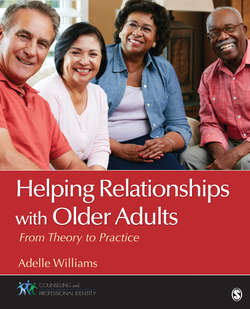Читать книгу Helping Relationships With Older Adults - Adelle M. Williams - Страница 77
На сайте Литреса книга снята с продажи.
Nutrition
ОглавлениеNutrition is an essential element not only in weight management and disease prevention, but additional considerations that are critical to older adults. Adequate calcium consumption is necessary to prevent bone loss. During perimenopause and menopause, bone loss accelerates rapidly, with an average of about 3% skeletal mass lost per year over a 5-year period. Vitamin D is necessary for adequate calcium absorption, yet as people age, particularly in their 50s and 60s, they do not absorb vitamin D from foods as readily as they did in their younger years. If vitamin D is unavailable, calcium levels are also likely to be lower. As older adults become more concerned about cholesterol and fatty foods, and as their budgets shrink, they often cut back on protein. Because protein is necessary for muscle mass, protein insufficiencies can spell trouble. Other nutrients, including folic acid (folate), vitamin E, iron, potassium, and vitamin B12, are important to the aging process, and most of these are available in any diet that follows the nutrition guidelines for older adults (U.S. Department of Agriculture & U.S. Department of Health and Human Services, 2015).
The U.S. government’s Dietary Guidelines for Americans 2015 includes the following recommendations for a healthy lifestyle and diet (U.S. Department of Agriculture & U.S. Department of Health and Human Services, 2015). Individuals are encouraged to adhere to dietary patterns that emphasize the following items.
Consume a variety of foods within and among the basic food groups while staying within energy needs.
Consume dietary patterns that are higher in vegetables, fruits, and whole grains.
Include seafood and legumes.
Moderate intake of dairy products (with an emphasis on low and non-fat dairy).
Moderate consumption of alcohol.
Lower intake of meats (including red and processed meats).
Lower intake of sugar-sweetened foods, beverages, and refined grains.
Limit sodium and saturated fat.
Tailor dietary patterns to individuals’ biological, cultural, and individual food preferences.
Control caloric intake to manage body weight.
Be physically active every day.
Keep food safe to eat.
The Older Americans 2012 report (Federal Interagency Forum on Aging-Related Statistics, 2012) identifies guidelines to improve the nutritional health of older Americans. Major improvements in the nutritional health of older Americans could be made by increasing intakes of whole grains, dark green and orange vegetables and legumes, and fat-free or low-fat milk products. Additionally, incorporating foods and beverages that are lower in sodium and have fewer calories from solid fats, alcoholic beverages, and added sugars is also recommended (Federal Interagency Forum on Aging-Related Statistics, 2012). A healthy diet for an older person must take into account the slowing of the system with age, the body’s increased sensitivity to extremes (like hot, spicy, and rich foods), and the body’s need for high-quality nutrients with minimal calories. Guided Practice Exercise 3.5 provides the opportunity to conduct a nutritional assessment of an elderly client and determine ways to enhance his or her nutritional intake to prevent and/or decrease health conditions.
Guided Practice Exercise 3.5
Identify an elderly man or woman and have him or her complete a 3-day nutritional intake diary. Take this data and give them to a nutritionist for a dietary analysis. Once analyzed, discuss with the nutritionist how you should relay this information to your client and any medical conditions associated with inadequate nutritional habits.
Calorie needs decline with age due to a slow-down in metabolism and physical activity, nutritional requirements may remain the same or in some cases increase. My Plate for Older Adults provides examples of foods that contain high levels of vitamins and minerals per serving and is consistent with the federal dietary guidelines (USDA Human Nutrition Research Center on Aging, 2011). These calories should be gained through a healthy diet, such as that shown in Table 3.2.
A healthy diet is essential to everyday life and prevention and controlling chronic disease. As people age, they need to obtain maximum nutrition with the fewest calories. Guided Practice Exercise 3.6 addresses how a person’s diet plays a role in controlling the chronic medical condition, diabetes. If it is improperly managed, it poses serious long-term health risks. Practitioners will be confronted with clients with diabetes and will be challenged to address their noncompliance issues in a constructive manner.
Guided Practice Exercise 3.6
Diabetes is a chronic disease that affects many older persons. This disease is managed by altering one’s diet, exercise, and/or medication. Many older persons live comfortable lives and manage this chronic disease effectively. Visit an assisted living facility and discuss your knowledge of diabetes with an elderly individual. Find ways to convince your resident of the necessity in following a diabetic diet to decrease his or her potential for insulin injections. Make sure you have thoroughly researched the topic and obtained data pertinent to diabetes management and older adults. What did you learn from this experience and how will it help you when working with older clients?
Table 3.2
Source: USDA Human Nutrition Research Center on Aging (2011).
